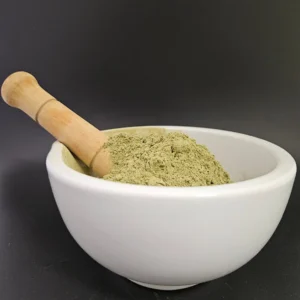Understanding the Potential Side Effects of Kratom: An In-Depth Analysis
Kratom, a tropical tree native to Southeast Asia, has been used for centuries for its unique properties. In recent years, its popularity has surged globally, particularly in the United States, as people seek natural alternatives for mood enhancement and energy boosts. However, like any substance, it is not without its potential side effects. This blog post aims to provide a comprehensive overview of the potential side effects of kratom, helping users make informed decisions.
What is Kratom?
Before diving into the potential side effects of Kratom, it’s essential to understand what kratom is. It (Mitragyna speciosa) is a plant indigenous to Thailand, Indonesia, Malaysia, and Papua New Guinea. The leaves of the kratom tree contain compounds (Alkaloids) that have relaxing and energizing effects. The primary active ingredient in kratom is mitragynine.

Yellow Maeng Da Batch 151210 kratom powder beautifully displayed in a bowl, highlighting its fine texture and quality.
Common Side Effects of Kratom
1. Nausea and Vomiting
One of the most frequently reported side effects of kratom is nausea, which can sometimes lead to vomiting. This reaction is often dose-dependent, meaning higher doses are more likely to cause these symptoms. Users new to kratom may also experience nausea as their bodies adjust to the substance.
2. Constipation
Kratom can cause constipation because it slows down the digestive system, leading to less frequent bowel movements. Long-term users of kratom often report experiencing constipation, which can be uncomfortable and sometimes lead to more serious gastrointestinal issues.
3. Dizziness and Drowsiness
Kratom can cause dizziness and drowsiness, particularly at higher doses. These side effects of Kratom can impair the user’s ability to perform tasks that require concentration, such as driving or operating machinery. It is advisable to avoid such activities until you know how it affects you.
4. Dry Mouth
Another common side effect of kratom is dry mouth, often referred to as “cotton mouth.” This occurs because it can reduce saliva production. Staying hydrated by drinking plenty of water can help mitigate this effect.
5. Increased Urination
Some users report increased frequency of urination when using it. While this side effect is not as widely discussed as others, it can be inconvenient and may lead to dehydration if not properly managed. Kratom is a diuretic like coffee, so drinking plenty of water is key to feeling great while taking it.
6. Loss of Appetite
Kratom can suppress appetite in some users. While this might be beneficial for those looking to lose weight, it can be problematic for others, especially if it leads to unintentional weight loss or nutritional deficiencies. There have been reports of people gaining weight from increased appetite while taking it too, so this may be a way of the body balancing itself out.
Psychological Side Effects of Kratom
1. Restlessness and Irritability
While many users take kratom for its relaxing effects, it can paradoxically cause restlessness and irritability in some individuals, especially at higher doses. This reaction can be distressing and counterproductive for those using it for its calming effects. Red Kratom Strains are known for more relaxing effects since they are usually lower in Mitragynine.
2. Insomnia
Kratom’s stimulating effects can interfere with sleep, particularly if taken in large doses or close to bedtime. Insomnia and disrupted sleep patterns are common complaints among users, especially those who use white vein strains known for their energizing properties.
3. Mood Swings and Irritability
Some users experience mood swings and irritability when using it. These mood changes can affect personal relationships and overall well-being, so make sure that kratom is compatible with you body’s chemistry before using it.
Long Term Risks & Side Effects of Kratom
1. Dependence and Withdrawal
One of the most significant concerns with heavy long-term kratom use is the potential for dependence and withdrawal. Regular use of kratom can lead to physical dependence, meaning the body becomes accustomed to the substance and requires it to function normally.
When a dependent user stops taking it, they may experience withdrawal symptoms such as:
- Irritability
- Insomnia
- Muscle aches
- Runny nose
- Nausea
2. Liver Damage
Although rare, there have been reports of liver damage associated with kratom use. Symptoms of liver damage include fatigue, dark urine, and jaundice (yellowing of the skin and eyes). If you experience any of these symptoms, it’s crucial to seek medical attention immediately.
3. Cardiovascular Issues
Kratom can affect the cardiovascular system, potentially leading to increased heart rate and blood pressure. While these effects are typically mild, they can pose risks for individuals with pre-existing heart conditions. It’s essential to monitor your cardiovascular health and consult a healthcare provider if you have concerns.
Mitigating Side Effects of Kratom
1. Start with Low Doses
To minimize the risk of side effects of kratom, start with a low dose of kratom and gradually increase it as needed. This approach allows your body to adjust to the substance and helps you find the lowest effective dose.
2. Stay Hydrated
Drinking plenty of water can help counteract dry mouth and prevent dehydration, especially if you experience increased urination.
3. Maintain a Healthy Diet
A balanced diet rich in fiber can help prevent constipation. If you experience loss of appetite, focus on nutrient-dense foods to ensure you’re getting the necessary vitamins and minerals.
4. Avoid Mixing with Other Substances
Combining kratom with other substances, particularly alcohol or other opioids, can increase the risk of side effects and potential toxicity. It’s best to use it on its own to understand its effects on your body.
5. Take Breaks
Regular breaks from kratom use can help prevent dependence and reduce the risk of withdrawal symptoms. These breaks allow your body to reset and decrease the likelihood of developing tolerance.
Conclusion – Side Effects of Kratom
While it offers potential benefits, including increased energy and mood enhancement, it is not without its side effects. Understanding these potential adverse effects is crucial for making informed decisions about kratom use. By starting with low doses, staying hydrated, maintaining a healthy diet, and taking regular breaks, you can minimize the risks associated with it.
Always consult with a healthcare provider before starting any new supplement, especially if you have underlying health conditions or are taking other medications. By approaching kratom use responsibly and with awareness, you can enjoy its benefits while minimizing potential drawbacks.
For more information on kratom, its uses, and tips for safe consumption, visit our website. We provide a range of high-quality, lab-tested kratom products to support your well-being.







0 Comments